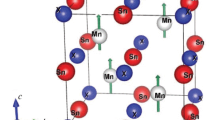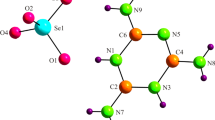Abstract
The electronic structure and the total energy of Ti2AlC, Ti2AlN, Ti2SiC, and Ti2SiN compounds have been explored by the methods of the density functional theory and pseudopotentials. Density curves of electronic states for the crystal systems and for the systems differing in the degree of order have been plotted. It is shown that the qualitative similarity of electronic structure with the electronic structure of corresponding crystalline compounds is observed even in completely disordered systems. This similarity increases with the ordering. The total energy of the studied systems grows with the increase in disorder in approximately the same way for all the systems investigated, except Ti2SiC. In the latter case, the system is much more sensitive to the degree of disorder, most likely due to the greater role of the covalent component of the interatomic bonds.


Similar content being viewed by others
REFERENCES
Y. C. Zhou and Z. M. Sun, Phys. Rev. B 61, 12570 (2000).
J. Y. Wang, Y. C. Zhou, Z. J. Lin, F. L. Meng, and F. Li, Appl. Phys. Lett. 86, 101902 (2005).
J. E. Spanier, S. Gupta, M. Amer, and M. W. Barsoum, Phys. Rev. B 71, 012103 (2005).
Y. Khoptiar and I. Gotman, Mater. Lett. 57, 72 (2002).
X. H. Wang and Y. C. Zhou, Z. Metallk. 93, 66 (2002).
Y. C. Zhou and X. H. Wang, Mater. Res. Innovat. 5, 87 (2001).
X. H. Wang and Y. C. Zhou, Oxid. Met. 59, 303 (2003).
M. W. Barsoum, M. Ali, and T. El-Raghy, Met. Mater. Trans. A 31, 1857 (2000).
J. M. Guo, K. X. Chen, Z. B. Ge, H. P. Zho, and X. S. Ning, Acta Met. Sinica 39, 315 (2003).
X. L. Hong, B. C. Mei, J. Q. Zhu, and W. B. Zhou, J. Mater. Sci. 39, 1589 (2004).
O. Wilhelmsson, J. P. Palmquist, T. Nyberg, and U. Jansson, Appl. Phys. Lett. 85, 1066 (2004).
J. Y. Wang and Y. C. Zhou, Phys. Rev. B 69, 214111 (2004).
M. W. Barsoum, MAX Phases: Properties of Machinable Ternary Carbides and Nitrides, 1st ed. (Wiley-VCH, New York, 2013).
A. Rahman and Z. Rahaman, Am. J. Mod. Phys. 4, 70 (2015).
Z. J. Lin, M. J. Zhuo, Y. C. Zhou, M. S. Li, and J. Y. Wang, Acta Mater. 54, 1009 (2006).
M. A. Teslina, T. B. Ershova, N. M. Vlasova, and I. A. Astapov, Perspekt. Mater. 3, 75 (2016).
W. B. Zhou, B. C. Mei, J. Q. Zhu, and X. L. Hong, Mater. Lett. 5, 131 (2005).
O. Wilhelmsson, J.-P. Palmquist, T. Nyberg, and U. Jansson, Appl. Phys. Lett. 85, 1066 (2004).
M. Magnuson and M. Mattesini, Thin Solid Films 621, 108 (2017).
Jingyang Wang, Yanchun Zhou, Ting Liao, Jie Zhang, and Zhijun Lin, Scr. Mater. 58, 227 (2008).
Hui Wang, Han Han, Gen Yin, Chang-Ying Wang, Yu-Yang Hou, Jun Tang, Jian-Xing Dai, Cui-LanRen, Wei Zhang, and Ping Huai, Materials 10, 103 (2017).
Y. P. Gan, X. K. Qian, X. D. He, Y. X. Chen, S. N. Yun, and Y. Zhou, Phys. B (Amsterdam, Neth.) 406, 3847 (2011).
Y. Mo, P. Rulis, and W. Y. Ching, Phys. Rev. B 86, 165122 (2012).
G. Hug, Phys. Rev. B 74, 184113 (2006).
H. Li, Z. Wang, G. Sun, P. Yu, and W. Zhang, Solid State Commun. 237–238, 24 (2016).
M. Beckstedte, A. Kley, J. Neugebauer, and M. Scheffler, Comput. Phys. Commun. 107, 187 (1997).
M. Fuchs and M. Scheffler, Comput. Phys. Commun. 119, 67 (1999).
Wenxia Feng and Shouxin Cui, Can. J. Phys. 92, 1652 (2014).
Qing-He Gao, An Du, and Ze-Jin Yang, Mod. Phys. Lett. B 31, 1750016 (2017).
G. Hug and E. Fries, Phys. Rev. B 65, 113104 (2002).
V. G. Zavodinskii, Computer Simulation of Nanoparticles of Nanosystems (Fizmatlit, Moscow, 2013) [in Russian].
Du Yu-Lei, Chin. Phys. Lett. 26, 117102 (2009).
Author information
Authors and Affiliations
Corresponding author
Ethics declarations
The authors declare no conflicts of interest.
Additional information
Translated by N. Semenova
Rights and permissions
About this article
Cite this article
Zavodinskii, V.G., Gorkusha, O.A. Features of Forming the Electronic Structure at Synthesis of Ti2AlC, Ti2AlN, Ti2SiC, and Ti2SiN Compounds. Phys. Solid State 61, 2520–2524 (2019). https://doi.org/10.1134/S1063783419120618
Received:
Revised:
Accepted:
Published:
Issue Date:
DOI: https://doi.org/10.1134/S1063783419120618




